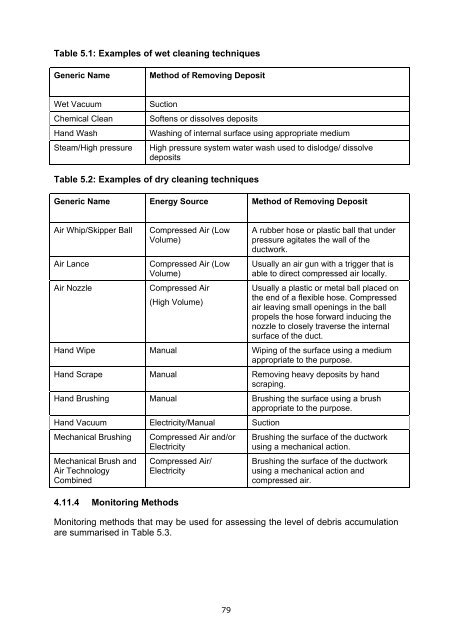Guidance on the Control of Odour and Noise from ... - Defra
Guidance on the Control of Odour and Noise from ... - Defra
Guidance on the Control of Odour and Noise from ... - Defra
You also want an ePaper? Increase the reach of your titles
YUMPU automatically turns print PDFs into web optimized ePapers that Google loves.
Table 5.1: Examples <strong>of</strong> wet cleaning techniques<br />
Generic Name Method <strong>of</strong> Removing Deposit<br />
Wet Vacuum Sucti<strong>on</strong><br />
Chemical Clean S<strong>of</strong>tens or dissolves deposits<br />
H<strong>and</strong> Wash Washing <strong>of</strong> internal surface using appropriate medium<br />
Steam/High pressure High pressure system water wash used to dislodge/ dissolve<br />
deposits<br />
Table 5.2: Examples <strong>of</strong> dry cleaning techniques<br />
Generic Name Energy Source<br />
Air Whip/Skipper Ball Compressed Air (Low<br />
Volume)<br />
Air Lance Compressed Air (Low<br />
Volume)<br />
Air Nozzle Compressed Air<br />
(High Volume)<br />
79<br />
Method <strong>of</strong> Removing Deposit<br />
A rubber hose or plastic ball that under<br />
pressure agitates <strong>the</strong> wall <strong>of</strong> <strong>the</strong><br />
ductwork.<br />
Usually an air gun with a trigger that is<br />
able to direct compressed air locally.<br />
Usually a plastic or metal ball placed <strong>on</strong><br />
<strong>the</strong> end <strong>of</strong> a flexible hose. Compressed<br />
air leaving small openings in <strong>the</strong> ball<br />
propels <strong>the</strong> hose forward inducing <strong>the</strong><br />
nozzle to closely traverse <strong>the</strong> internal<br />
surface <strong>of</strong> <strong>the</strong> duct.<br />
H<strong>and</strong> Wipe Manual Wiping <strong>of</strong> <strong>the</strong> surface using a medium<br />
appropriate to <strong>the</strong> purpose.<br />
H<strong>and</strong> Scrape Manual Removing heavy deposits by h<strong>and</strong><br />
scraping.<br />
H<strong>and</strong> Brushing Manual Brushing <strong>the</strong> surface using a brush<br />
appropriate to <strong>the</strong> purpose.<br />
H<strong>and</strong> Vacuum Electricity/Manual Sucti<strong>on</strong><br />
Mechanical Brushing Compressed Air <strong>and</strong>/or<br />
Electricity<br />
Mechanical Brush <strong>and</strong><br />
Air Technology<br />
Combined<br />
4.11.4 M<strong>on</strong>itoring Methods<br />
Compressed Air/<br />
Electricity<br />
Brushing <strong>the</strong> surface <strong>of</strong> <strong>the</strong> ductwork<br />
using a mechanical acti<strong>on</strong>.<br />
Brushing <strong>the</strong> surface <strong>of</strong> <strong>the</strong> ductwork<br />
using a mechanical acti<strong>on</strong> <strong>and</strong><br />
compressed air.<br />
M<strong>on</strong>itoring methods that may be used for assessing <strong>the</strong> level <strong>of</strong> debris accumulati<strong>on</strong><br />
are summarised in Table 5.3.
















